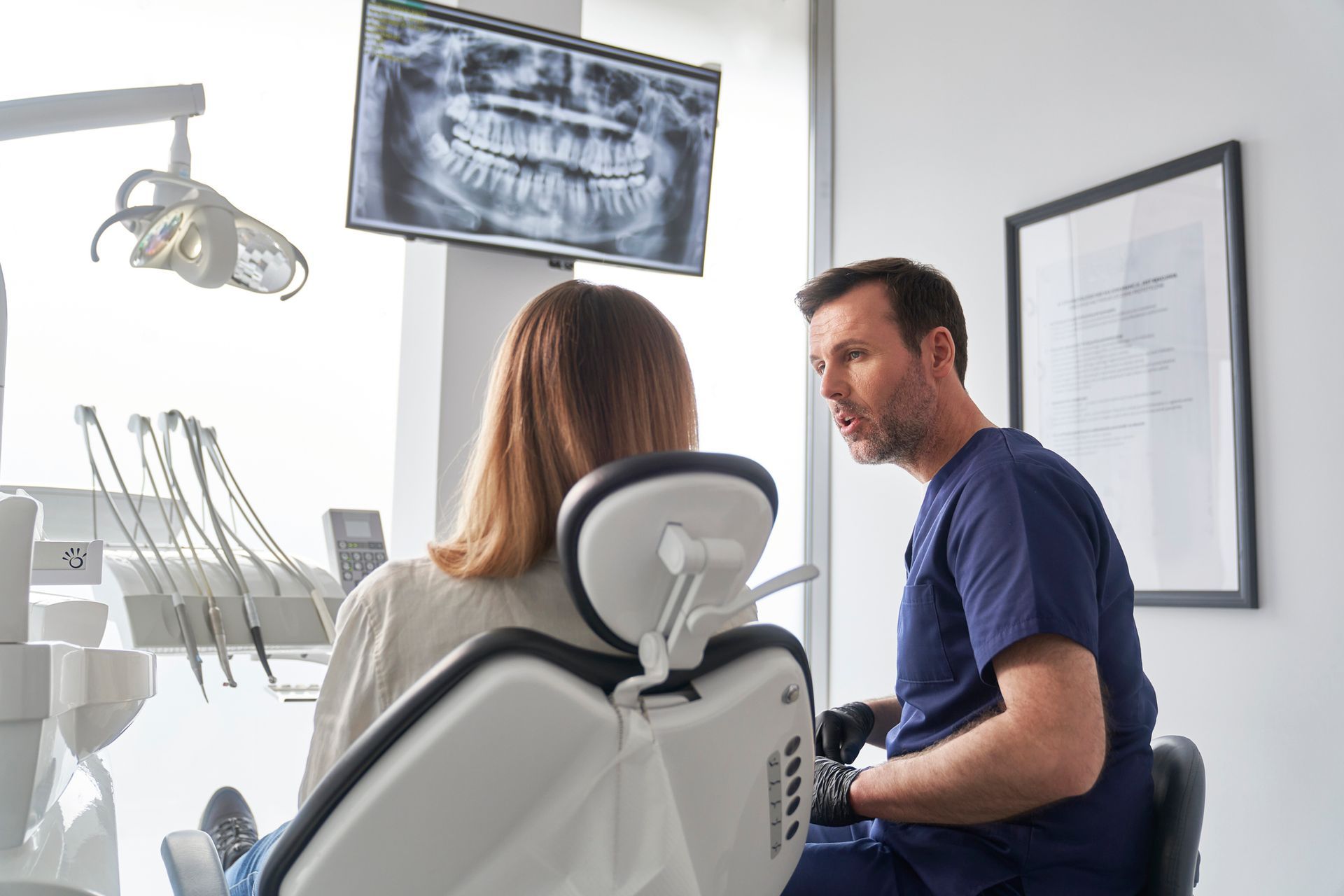A Complete Guide to All-on-4 Dental Implants: What Philadelphia Patients Need to Know
If you're tired of dealing with missing teeth, uncomfortable dentures, or the hassle of temporary fixes, All-on-4 dental implants might be the life-changing solution you've been searching for. At 360 Dental PC in Philadelphia, PA, we specialize in helping patients regain their confidence and quality of life with this revolutionary dental procedure.
In this comprehensive guide, we'll break down everything you need to know about All-on-4 dental implants—how they work, their benefits, the treatment process, costs, and why so many Philadelphia residents are choosing this advanced dental solution.
What Are All-on-4 Dental Implants?
All-on-4 dental implants are a full-arch tooth replacement solution that uses just four strategically placed dental implants to support a complete set of prosthetic teeth. Unlike traditional dentures, which rest on the gums and can slip or cause discomfort, All-on-4 implants are anchored directly into the jawbone, providing superior stability and a natural feel.
This innovative technique was developed to offer patients a faster, more efficient alternative to traditional implant-supported dentures, which often require six to eight implants per arch. With All-on-4, the implants are placed at precise angles to maximize contact with the existing bone, often eliminating the need for bone grafting procedures.
Key Features of All-on-4:
- Minimal implants, maximum results: Only four implants per arch
- Fixed, permanent solution: No need for removal or adhesives
- Immediate function: Temporary teeth can often be placed the same day
- Aesthetic excellence: Custom-designed prosthetic teeth for a natural appearance
For many patients in Philadelphia, All-on-4 dental implants are the key to restoring their smile in both form and function, allowing them to eat, speak, and smile with complete confidence.
Why Choose All-on-4 Dental Implants Over Traditional Dentures?
Many patients in Philadelphia struggle with loose-fitting dentures, sore gums, and the constant worry of dentures slipping at the wrong moment. All-on-4 implants eliminate these concerns by offering:
1. Enhanced Stability and Comfort
Unlike dentures that merely rest on the gums, All-on-4 implants are surgically embedded into the jawbone. This creates a strong, stable foundation that mimics the function of natural tooth roots. You won't have to worry about embarrassing slips while speaking or eating, giving you newfound confidence in social and professional settings.
2. Preservation of Jawbone Health
When teeth are missing, the jawbone no longer receives the stimulation needed to maintain its density, leading to bone loss over time. This can result in facial sagging and a prematurely aged appearance. All-on-4 implants stimulate the bone, preserving its structure and helping maintain your facial aesthetics.
3. Improved Functionality
With All-on-4 implants, you can enjoy a diet that includes foods you might have avoided with traditional dentures—think apples, steak, and crunchy vegetables. The restoration of natural chewing ability improves not only your diet but also your overall health and digestion.
4. Long-Lasting Solution
While traditional dentures need periodic adjustments and replacements, All-on-4 implants are designed for long-term use. With proper care and maintenance, they can last 20 years or more, making them a cost-effective solution in the long run.
5. Boosted Self-Esteem
A beautiful, functional smile can transform your self-image. Patients often report a significant boost in self-confidence after receiving All-on-4 implants, positively impacting their personal and professional lives.
The All-on-4 Dental Implant Process at 360 Dental PC
At 360 Dental PC in Philadelphia, we believe in a personalized, patient-centered approach. Here’s what you can expect from the All-on-4 treatment journey:
Step 1: Comprehensive Consultation & Evaluation
Your journey begins with an in-depth consultation. Our experienced dental team will perform a thorough examination, which includes:
- Digital X-rays and 3D cone beam CT scans for precise imaging
- A review of your dental and medical history
- Assessment of jawbone density and oral health
This step is crucial for determining if you're a good candidate for the procedure and for developing a customized treatment plan tailored to your unique needs and goals.
Step 2: Customized Treatment Planning
We understand that every smile is unique. Based on your evaluation, we will design a personalized treatment plan that outlines:
- The exact placement of implants
- Any preparatory procedures needed (extractions, bone grafting if necessary)
- The timeline and steps of your treatment
- Transparent cost breakdown and financing options
Step 3: Implant Placement Surgery
On the day of surgery, you'll be made comfortable with local anesthesia and, if desired, sedation options for a relaxed experience. The four implants are strategically placed in the jawbone, with the posterior implants angled to maximize bone contact and stability.
Thanks to advanced surgical techniques and meticulous planning, most patients experience minimal discomfort during and after the procedure.
Step 4: Immediate Temporary Teeth
One of the greatest advantages of All-on-4 is the ability to leave the office with a functional, beautiful smile on the same day. A set of temporary prosthetic teeth will be attached to your implants, allowing you to eat soft foods and smile confidently during the healing period.
Step 5: Healing & Final Restoration
Over the next few months, the implants will integrate with your jawbone through a process called osseointegration. Once fully healed, we’ll replace the temporary teeth with your permanent, custom-designed prosthetic arch, crafted to match the appearance and function of natural teeth.
Our team at 360 Dental PC will be with you every step of the way throughout this journey, ensuring your comfort and satisfaction.
Who Is a Candidate for All-on-4 Dental Implants?
Not everyone qualifies for All-on-4 implants, but many patients who have been told they aren’t candidates for traditional implants find success with this approach. Ideal candidates include:
- Individuals with multiple missing teeth or failing teeth
- Long-time denture wearers looking for a permanent solution
- Patients with moderate bone loss (the angled placement of implants often bypasses the need for bone grafting)
- Non-smokers or those committed to quitting during the healing process
- Patients in good overall health, free of uncontrolled chronic conditions
If you're unsure about your eligibility, our Philadelphia dental team offers comprehensive evaluations to determine the best solution for your needs.
How Much Do All-on-4 Dental Implants Cost in Philadelphia?
The cost of All-on-4 dental implants is a significant investment, but one that pays off in terms of quality of life, appearance, and long-term oral health.
Factors Influencing Cost:
- Complexity of your case and any additional procedures (extractions, bone grafting)
- Type of prosthetic materials used (acrylic vs. zirconia)
- Expertise of the dental provider
- Laboratory and surgical fees
In Philadelphia, the average cost for All-on-4 dental implants ranges between $20,000 to $30,000 per arch. While this might seem steep, consider the durability and benefits compared to other tooth replacement options.
Affordable Financing Options
At 360 Dental PC, we offer:
- Flexible payment plans
- In-house financing options
- Partnerships with third-party financing providers (CareCredit, LendingClub)
Our team will work with you to find a financial solution that fits your budget, so you can achieve the smile you deserve.
Frequently Asked Questions About All-on-4 Implants
Is the Procedure Painful?
Thanks to advanced anesthesia and sedation options, most patients report only mild discomfort, similar to what you'd feel after a tooth extraction. Any post-surgery soreness can typically be managed with over-the-counter pain relievers.
How Long Will the Implants Last?
With proper care, including regular dental check-ups and good oral hygiene, All-on-4 implants can last 20+ years. The prosthetic teeth may require replacement after 10-15 years due to normal wear.
What Foods Can I Eat After Surgery?
Initially, a soft food diet is recommended. As healing progresses, you'll be able to enjoy a full range of foods, from crunchy vegetables to steaks, without the worry of shifting dentures.
How Do I Maintain My All-on-4 Implants?
Daily brushing, flossing, and using water flossers will help maintain your implants. Regular visits to 360 Dental PC for professional cleanings and check-ups are essential to ensure long-term success.
Can All-on-4 Implants Be Done on the Upper and Lower Jaw?
Yes! All-on-4 dental implants can be performed on the upper jaw, lower jaw, or both arches simultaneously. Many patients opt for a full-mouth restoration, replacing all their teeth in a single treatment plan. Whether you need just one arch or a complete set of teeth, the All-on-4 method offers a comprehensive and efficient solution. Our team at 360 Dental PC will evaluate your specific needs and recommend the best approach for your smile transformation.
What Happens If an Implant Fails?
While implant failure is rare, it can occasionally occur due to factors like insufficient bone integration, infection, or poor oral hygiene. If an implant fails, our skilled team at 360 Dental PC will assess the situation and recommend corrective measures. This may include replacing the failed implant, addressing any underlying issues, and ensuring a successful outcome. Proper aftercare, routine dental visits, and following post-operative instructions greatly minimize the risk of implant failure.
Why Choose 360 Dental PC for All-on-4 Implants in Philadelphia?
Choosing the right dental provider is crucial for the success of your All-on-4 treatment. At 360 Dental PC, we offer:
- Highly skilled implant specialists with years of experience
- Advanced imaging and surgical technology
- Comprehensive, patient-centered care
- Transparent pricing and flexible financing options
- A welcoming, stress-free environment in the heart of Philadelphia, PA
Our commitment is to help you achieve a smile that is not only beautiful but also functional and long-lasting.
Schedule Your All-on-4 Consultation Today
If you're ready to reclaim your smile and improve your quality of life, All-on-4 dental implants could be the perfect solution. Contact 360 Dental PC in Philadelphia today to schedule your no-obligation consultation.
Your journey to a confident,
radiant smile starts here.












